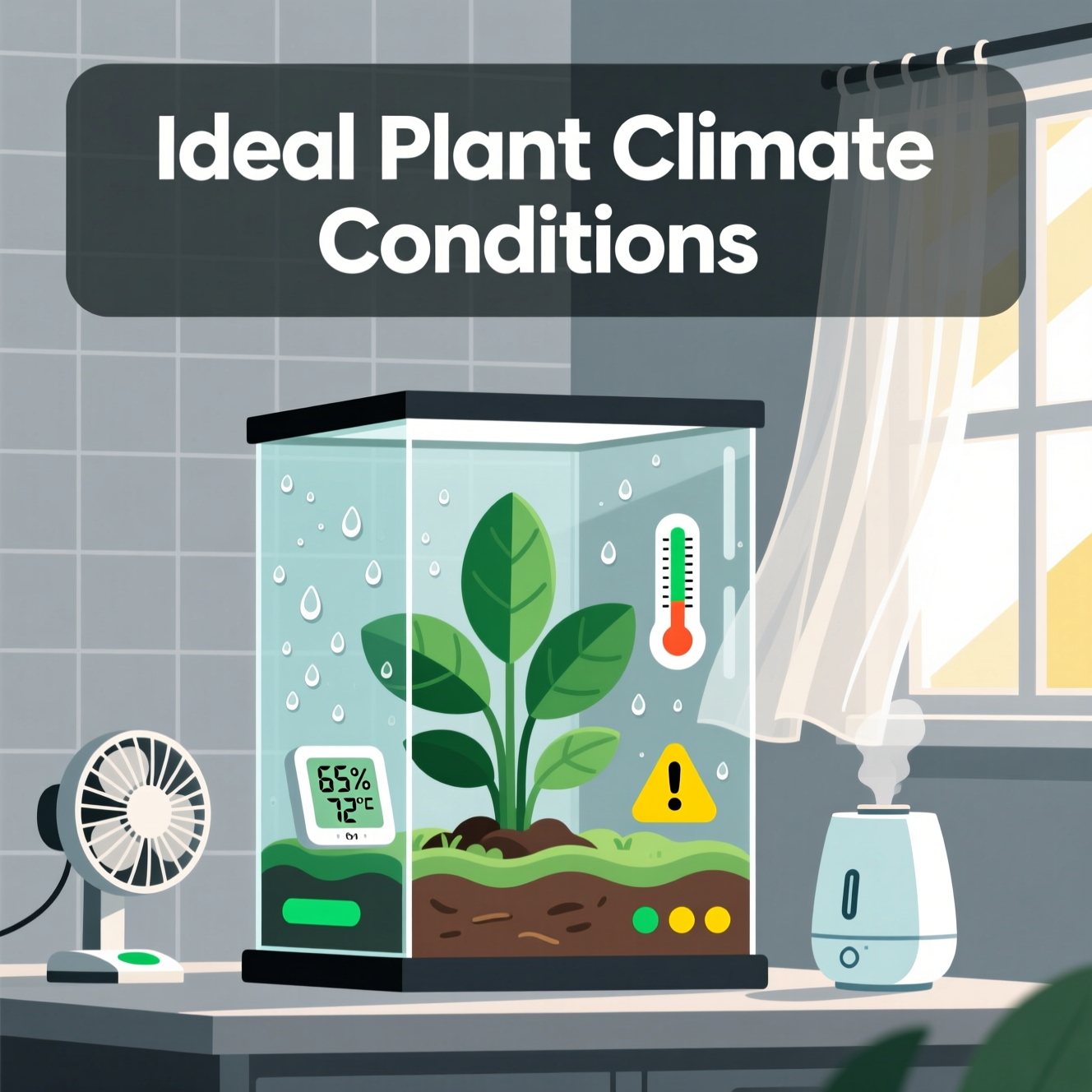Why Temperature and Humidity Matter for Plants
Understanding plant temperature range and plant humidity needs is crucial. Temperature regulates key processes like photosynthesis and nutrient uptake. Humidity significantly impacts transpiration rates, affecting how plants absorb water. For most gardeners, maintaining ideal conditions for plant growth directly translates to healthier plants and higher yields. Recent studies highlight the intricate relationship between these environmental factors and plant metabolism.
Every 5°C drop below optimal can reduce growth rates by up to 30% in sensitive species. Relative humidity influences the vapour pressure deficit (VPD), a metric integrating both temperature and humidity. High VPD can lead to excessive water loss, stressing the plant. Conversely, low VPD can hinder transpiration. Optimized thermoregulation and controlled transpiration are essential for robust development, as emphasized by current best practices.
In summary, managing temperature and humidity ensures optimal photosynthesis rate and nutrient absorption. This careful control enhances crop yield and plant vigor. Specialized knowledge of these elements allows for more efficient cultivation, promoting sustainable plant development in diverse environments.
Measuring Temperature and Humidity Accurately
Accurate indoor climate monitoring is essential for optimal plant growth. Utilizing advanced instrumentation, such as Pennsylvania State Extension highlights, ensures reliable readings. This involves precise sensor placement and rigorous calibration techniques. Digital hygrometers and data loggers provide real-time humidity tracking in microclimates, a critical factor for preventing fungal diseases and promoting healthy transpiration.
For effective measuring plant temperature, infrared thermometers allow non-contact surface temperature readings of leaves and substrate. This capability is invaluable for detecting localized temperature variations without disturbing the plant. By comparison, direct contact sensors can offer continuous data. In practice, consistent sensor calibration is paramount. Calibrated sensors maintain accuracy within ±0.7°C for temperature and ±2% for relative humidity, ensuring measurement error stays within acceptable scientific parameters.
Selecting the best sensors for plant climate control means prioritizing accuracy and reliability. Understanding the nuances of sensor placement, for instance, in relation to air circulation and potential heat sources, directly impacts data integrity. By implementing these practices, growers can achieve superior control over greenhouse humidity and temperature, leading to healthier, more productive plants.
Setting Ideal Temperature Ranges for Different Plants
Understanding optimal plant temperature is crucial for vigorous growth. Different plant types have distinct temperature thresholds. For instance, cool-season crops prefer cooler conditions than warm-season crops. According to UMass Extension, managing greenhouse temperatures effectively is key to maximizing yield.
Leafy greens thrive between 16–21°C. Fruiting plants prosper in 18–26°C daytime ranges. Night temperatures should not fall more than 5°C below daytime for most greenhouse crops. This diurnal variation impacts development significantly. Maintaining optimal temperature improves overall yield by up to 22% compared to unregulated conditions. Current best practices recommend monitoring microclimates at canopy, root zone, and air layers.
Managing Humidity for Plant Health
Optimizing relative humidity is crucial for plant vitality. For most greenhouse-grown species, maintaining a range between 50–70% ensures healthy development. This balance supports proper stomatal conductance. As a solution to common risks, targeting humidity levels prevents issues like mold. According to University of Minnesota Extension, controlling humidity is a key aspect of greenhouse management.
High humidity often leads to mold prevention challenges. Greenhouse mold control requires active management. Reducing relative humidity below 60% can significantly cut powdery mildew incidence by 40% in controlled studies. To improve outcomes, dehumidifier use is often recommended. Targeted ventilation also plays a vital role in this process. These methods help protect plants from detrimental fungal outbreaks.
Conversely, mist and fog systems can effectively increase humidity when needed. However, overuse can paradoxically cause problems. Excessive moisture may lead to root rot or other foliar diseases. Therefore, precise plant humidity adjustment is essential. Consistent monitoring and responsive techniques ensure ideal conditions for most plants.
Climate Control Tools and Technology
Effective greenhouse climate control relies on integrating advanced tools. Thermostat controllers manage heating and cooling systems precisely. Additionally, evaporative cooling units and exhaust fans are vital for temperature and humidity regulation, especially in warmer conditions. According to Penn State Extension, these systems ensure optimal plant environments.
Smart technology is transforming plant environment automation. IoT sensor networks provide real-time data on temperature, humidity, and CO2 levels. This data enables remote monitoring and feedback-based adjustments, enhancing scalability. Such climate automation ensures consistent conditions, with smart control systems maintaining temperature and humidity within ±1°C and ±5% RH 95% of the time.
Implementing a robust greenhouse climate control strategy is key. Thermostatic controllers offer automated responses to environmental changes. Furthermore, IoT sensors empower growers with detailed insights for proactive management. These technologies collectively ensure stable, predictable conditions for superior plant growth.
Common Problems and Adjustment Methods
Maintaining optimal plant temperature and humidity requires vigilance. Heat spikes can occur unexpectedly from intense sun. In summary, to solve humidity problems and troubleshoot plant environments, responsive adjustments are key. For most gardeners, addressing these issues promptly ensures plant health.
Condensation forms when air temperature drops below the dew point. Therefore, increasing airflow or gentle heating can mitigate this. Environmental drift is also a concern, often minimized by regular sensor checks and system recalibration. Responsive climate adjustment reduces stress-related plant losses by 28% over passive systems. Such measures enhance overall system stability and performance.

Angelina Everly leads the editorial desk at Live Green Gardens, blending practical plant care, hands-on product testing, and approachable outdoor styling. She focuses on step-by-step how-tos, buyer’s guides, and small-space makeovers that work in real life and real budgets. When she’s not comparing pruning shears or setting up a drip kit, you’ll find her creating cozy corners with planters, solar lights, and pollinator-friendly picks—always with clear pros/cons and safety notes so you can buy once and garden happy.

